|
LES TRULLI OU
CASEDDE D'ALBEROBELLO (PROVINCE DE BARI, ITALIE)
À TRAVERS LES CARTES POSTALES ET PHOTOS ANCIENNES
The trulli or
casedde of Alberobello, province of Bari, Italy,
through old postcards and photos
Christian Lassure
version française
III - LES AVATARS DE LA RUE MONTE PERTICA AU QUARTIER MONTI (1950-2010)
III - THE CHANGING FACE OF VIA MONTE PERTICA IN THE MONTI DISTRICT (1950-2010)
|
Monte Pertica
street is in the Monti district ("the district of the Mounts"),
a hill in the southern part of Alberobello. The street leads through
Piazza d'Annunzio into via San Michele, forming an arc of circle from
San Antonio de Padova church in the west to the Largo Martellotta
market place in the north.
|
|
|
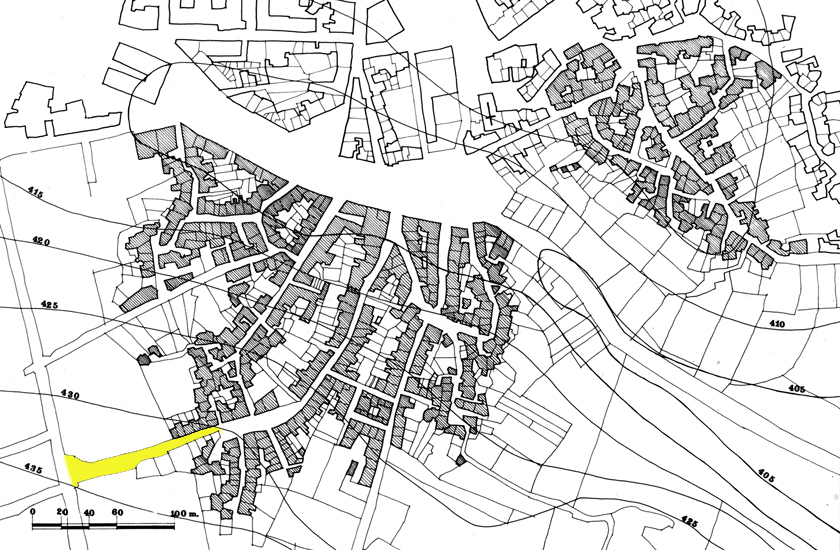 |
|
Map of the southern part of the town of Alberobello with
its two trullo zones, the Monti district on the left, and the Aia Piccola
district on the right. |
|
|
|
DOCUMENT 1 |
|
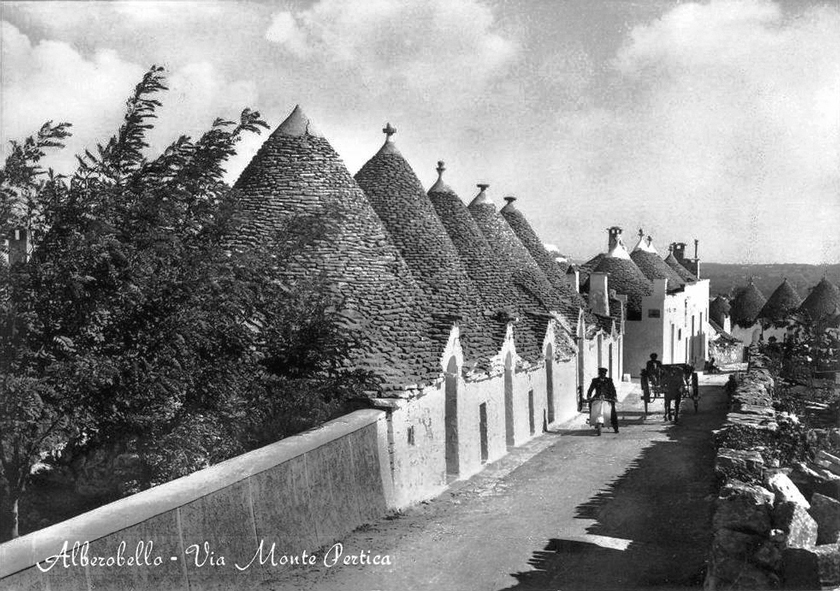 |
|
Black and white postcard of the mid 1950s (a coloured version also exists). Publisher:
Mostra dei Trulli. Photo by Fanizzi Bernardino. |
|
In this black and white photograph of the mid-nineteen fifties, a row of several
trullo houses with same-size conical roofs can be seen as a continuation
of the modern wall on the left. Beyond the small recess formed by a crosswise
street, a second row of houses extends further down. Via Monte Pertica is a
narrow street with a dry stone wall lining a number of small front gardens on
the side opposite the trullo houses. A traditional horse-driven cart and
a vespa, the popular two-wheeler of the time, are seen side by side halfway
along the street. No whitewashed symbol is visible across the front of the
trullo roofs. |
|
|
|
DOCUMENT 2 |
|
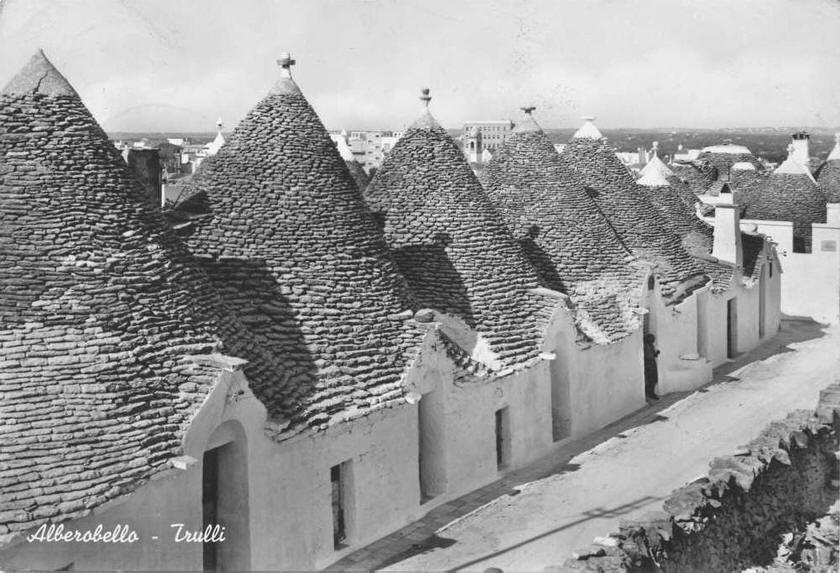 |
|
Black and white postcard of the 1950s. |
|
The same row of houses as seen from the top of a building on the
opposite side of the street. There are as many as six trullo cones, all
of identical size except the smaller one furthest to the right.
Each apex is different, though. From left to right, there are:
1 - an apex rendered with mortar;
2 - a pinnacle consisting of a circular slab topped with a ball;
3 - a pinnacle consisting of an upturned cone topped with a ball;
4 - a pinnacle consisting of a mere circular slab;
5 - a pinnacle identical to the previous one, but whitewashed;
6 - an apex rendered with mortar, complete with whitewash.
The structure of the dry stone wall across from the row of trullo houses
comes out plainly: battered facings, a coping of large slabs set on edge (hence
the serrated shadow visible in the previous postcard). |
|
|
|
DOCUMENT 3 |
|
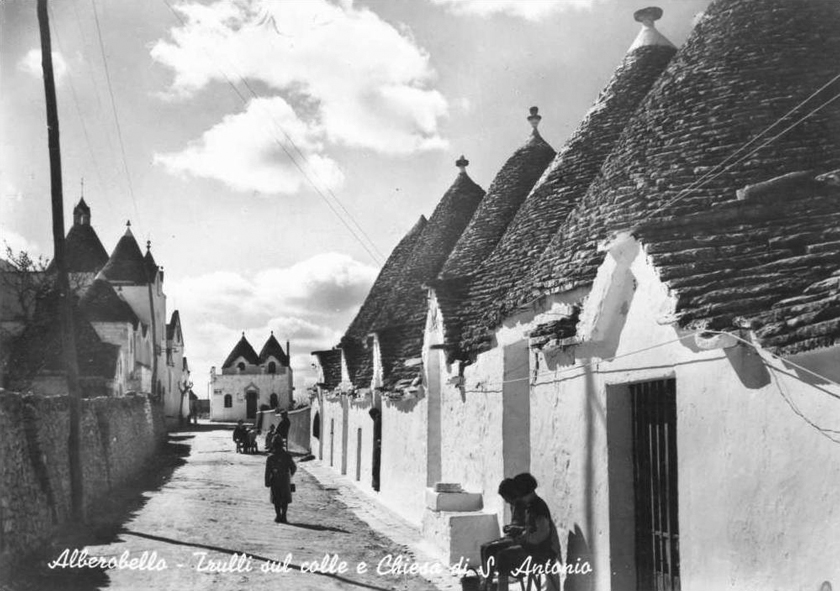 |
|
Black and white postcard of the 1950s. Publisher : Ditta Cav. Giuseppe Lo Buono /
Via Roberto da Bari 6 - Bari. Foto Mastrorilli - Bari. |
|
In this third postcard
of the 1950s, Monte Pertica street is
seen from its eastern end. In the background, to the left, stand the façade and
trullo cones of the church of Saint Anthony, built in 1926. Facing the western
end of the street, on Cadore street, can be seen a house topped with two trullo
cones, of contemporary date with the church. A whitewashed symbol is apparent on
the fourth cone (from the left) of the row of trulli. There is some animation in
the street: residents are sitting on chairs outside their houses, having a chat
or going about some household chore, a familiar sight in the car-less streets of the
time. |
|
|
|
DOCUMENT 4 |
|
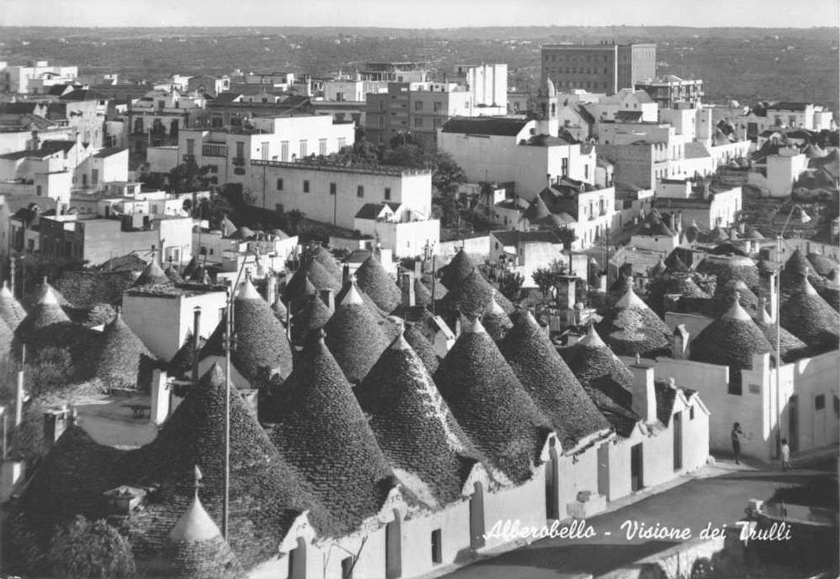 |
|
Black and white postcard of the 1950s-1960s. |
|
This view of Monte Pertica street was shot from the roofs of the
church of Saint Anthony. The high angle brings into view the
square buildings of the town's more modern parts. Across the front of the third
cone (from the left of the row of houses), a whitewashed symbol reminiscent of a
bough has been painted. The roadway has been widened, resulting in the dry stone
wall visible in the preceding postcards being replaced by mortared stonework.
Sticking out obliquely from the façade of trullo N. 1 (at the west end of the
row), is a forked perch used for supporting a clothes line. Beyond the east end
of the row, at the inception of Piazza d'Annunzio, stands a trullo house
whose walls have been raised to make it look like a modern house. |
|
|
|
DOCUMENT 5 |
|
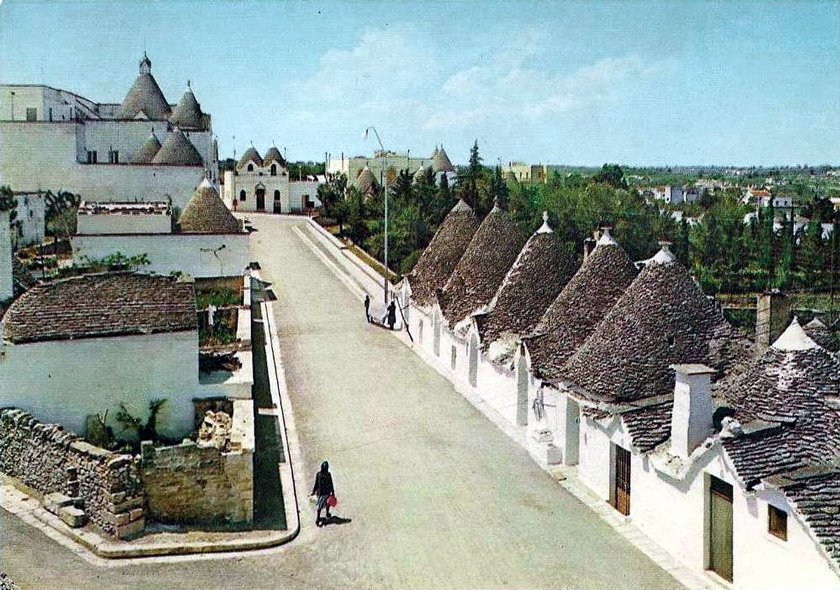 |
|
Colour postcard of the 1960s. Publisher: Cav. G. Lobuono - Bari. |
|
With this colour postcard, we move on to the 1960s. The picture is taken from
the East and from a high angle. The street surface has been widened and
fitted with a pavement on its left-hand side. The wall alongside the garden
plots has been moved back and rebuilt to modern standards. The five high cones
and the small one are easily recognizable. The bough-like symbol
whitewashed across the front of the third cone is still visible as well
as a cross splashed across the front of the smaller cone.
Curiously, the dry laid wall bordering the oblique street
in the left corner of the picture is equipped with a stone stile: the coping of
slabs set on edge gives way to an interval of slabs laid flat above a flight
of three steps projecting from the wall face and reached
via two big stone blocks acting as stepping stones. |
|
|
|
DOCUMENT 6 |
|
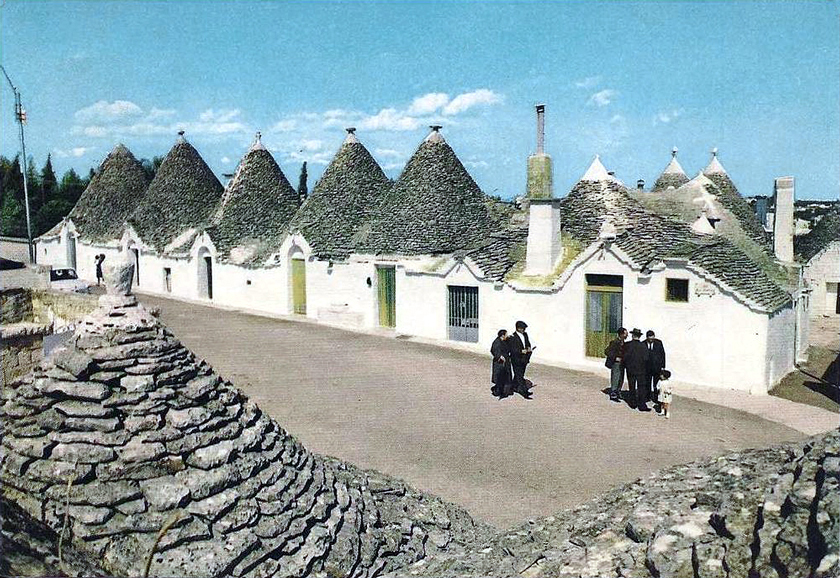 |
|
Colour postcard posted 1966. |
|
Another 1960s
colour postcard of the same row of houses, seen
from the roof of a trullo house on the opposite side of the street. The
various doorways fall into three morphological types: the first four on the left
are spanned by a semi-circular arch underneath a triangular pediment, the fifth
is spanned by a mere lintel, the 6th and 7th are spanned by a lintel underneath
a triangular pediment. The house at the extreme right is a multi-cell composite
structure and the only one with a chimney stack at the front. The people outside
are locals, unaware that they are being photographed. What appears to be the
front of a small Fiat can be seen close to the lamp post on the right, an
indication that the personal car is becoming popular.
The left-hand cone
in the foreground reveals the method with which roof stone tiles were laid in older
trullo roofs, i.e. with a slight outward slant and an exposed part that
diminishes as the slope increases. |
|
|
|
DOCUMENT 7 |
|
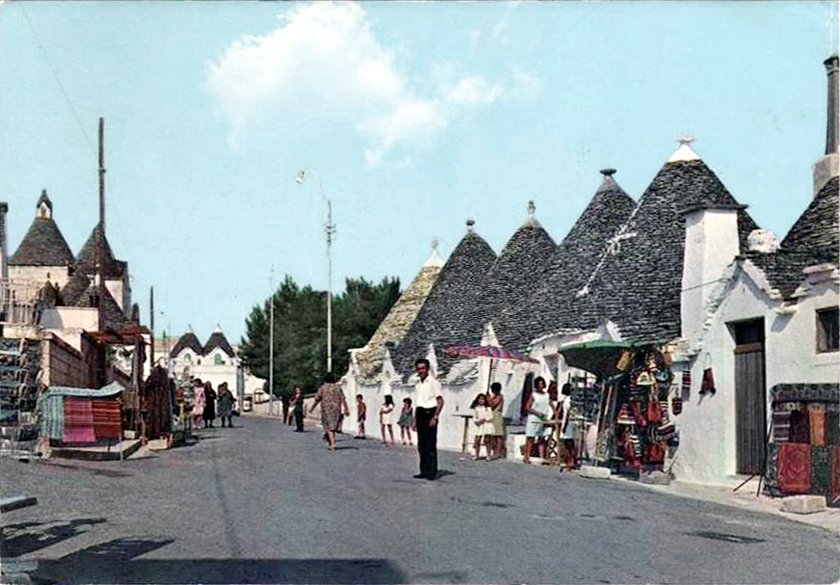 |
|
Colour postcard of the 1970s. |
|
A decade later, in
the 1970s, the scene has changed: judging from the stall outside two of the houses,
Tourism has made its debut. The roof of the house at the extreme left end of the
row has been rebuilt by local craftsmen, gaining in the process both a rectilinear
profile and a brand new carved pinnacle. The symbol painted on cone N. 3 has faded
away while another – a cross apparently – has popped up on cone N. 5. |
|
|
|
DOCUMENT 8 |
|
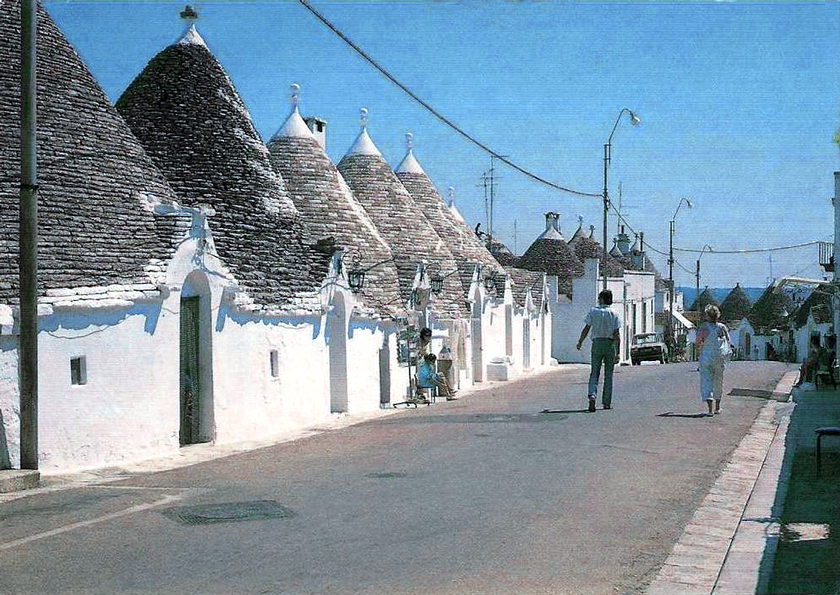 |
|
Colour postcard of the 1980s-90s. |
|
This postcard
of the 1980s-90s shows that trullo cones N. 3, 4 and 5 have been
completely rebuilt while trullo cone N. 1 has weathered to a grey shade.
The intervention of local roof repairers has resulted in all three
refurbished roofs gaining a perfectly linear profile. In the process, they have
been graced with the same slender pinnacle and adorned with painted symbols that
did not exist before. To add insult to injury, a fourth symbol has been painted
on cone N. 2. The doorway underneath cone N. 5 has been favoured with the
pediment it was lacking. The chimney stack between entrance N. 6 and
entrance N. 7 has vanished. As a final touch, lanterns have been mounted over
doorways N. 2, 3 and 4.
Two tourists, a man
and woman, happen to be strolling past a gift shop. A car is parked where via
Monte Pertica merges into Piazza d'Annunzio. |
|
|
|
DOCUMENT 9 |
|
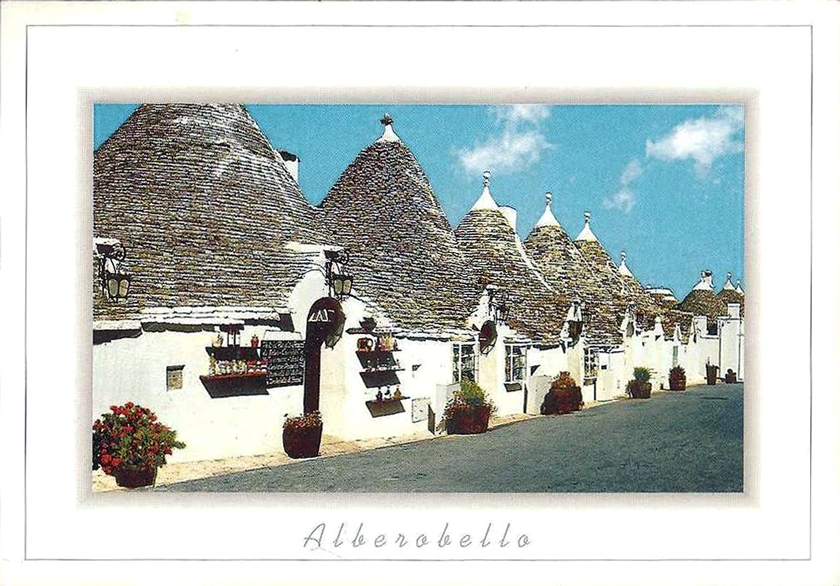 |
|
Colour postcard of the 1990s. Publisher: DELADUS. |
|
Judging
from this 1990s colour postcard, the conversion
of the row of trullo houses to Tourism is well on its way. Although
the roofs show no visible change as compared with the previous document
– cone N. 2 still retains its original curvilinear profile –, souvenir
shops have opened also in the first two houses: showcases and shelves
have been fixed to the front walls, another two lanterns embellish the
front of the first house. To alleviate the overly mineral appearance of
the row of trulli, plant tubs have been
installed outside. At the same time, cone N. 1 has been graced with the
whitewashed symbol it had been lacking so far. |
|
|
|
DOCUMENT 10 |
|
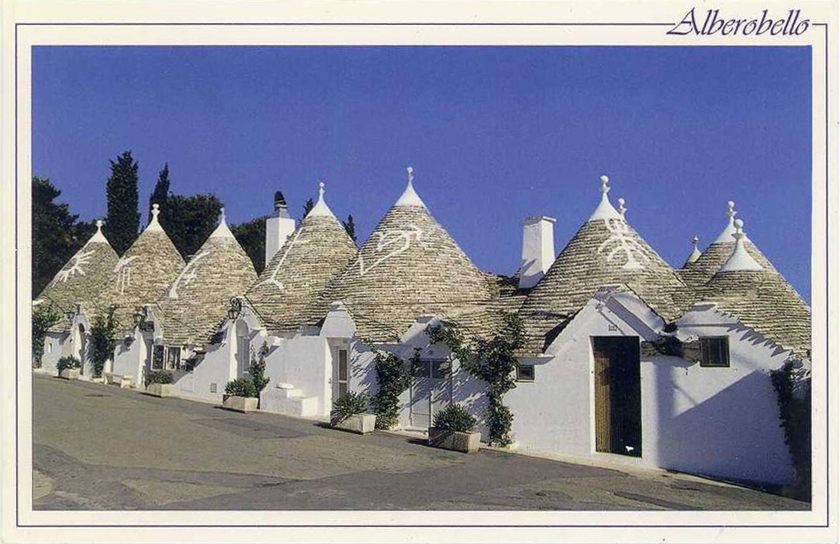 |
|
Colour postcard of the 2000s. |
|
This final
postcard ushers in the 2000s. The touristic conversion of the row of
trulli is now complete: all six cones have been rebuilt to the
same standards. In the process, cone N. 2 has also been adorned with a
brand new symbol. Climbing plants now cling to the front walls. The angle of
view allows the various painted symbols to be identified. (see next document). |
|
|
|
DOCUMENT 11 |
|
 |
|
Photographic montage from Wikipédia. |
|
A photographic montage, borrowed from Wikipedia, displays – albeit in a different
order from the actual one – the various symbols now extant
in Monte Pertica street. Starting from the left, we can see a cross on a pedestal, a
heart pierced by an arrow, a monstrance, a combined cross and tree (?), a dove
representing the Holy Spirit, a moon crescent next to a cross. As these
symbols have been added after the roofs were rebuilt by local craftsmen in the
late 20th century and early 21st century, we are left in
no doubt as to their lack of authenticity. |
|
|
|
DOCUMENT 12 |
|
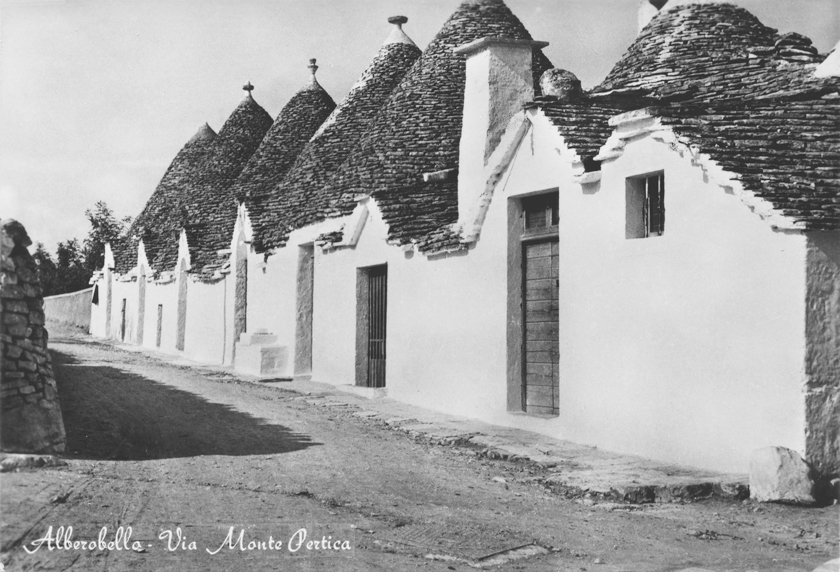
|
|
A last farewell to the original Monte Pertica
Street. |
To print, use
landscape mode
© CERAV
This page remains
subject to additional edits
Augmented on
February 1st, 2011 - June 19th, 2011 - August 23rd, 2011 - October 8th, 2011 -
March 6th, 2018
To be referenced as :
Christian Lassure
Series: The
trulli or casedde of Alberobello, province of Bari, Italy, through
old postcards and photos
III - The changing face of via Monte Pertica in the Monti district (1950-2010)
http://www.pierreseche.com/alberobello_monte_pertica_english.htm
January 20th, 2011
I -
Les trulli. Résumé historique et architectural
Trulli. A historical and architectural summary
II-
Photos de la première moitié du XXe siècle
Photos of the first half of the 20th century
III - Les avatars de la rue Monte Pertica au quartier
Monti (1950-2010)
The changing face of via Monte Pertica in the Monti district (1950-2010)
IV - L'hôtel des
trulli
The Hotel of the Trulli
V -
Rione Monti, via Monte Santo
VI - Rione Monti, via Monte Sabotino
VII - Rione Monti, via Monte San Michele
VIII - Rione Monti, via Monte Nero
(en construction)
IX - Rione Monti, via Monte Pasubio
(en construction)
X - Rione Monti, via Monte San Gabriele
XI - Rione Monti, via Duca d'Aosta
XII - Rione Monti, piazza d'Annunzio
(en construction)
XIII - Rione Monti, vico d'Annunzio
(en construction)
XIV - Rione Monti, Chiesa de Sant' Antonio
XV - Rione Monti, panorama della zona monumentale "Principe de
Piemonte" (en construction)
XVI - Rione Aia Piccola, piazza Plebiscito
XVII - Rione Aia Piccola, via Giuseppe Verdi
(en construction)
XVIII - Rione Aia Piccola, via Duca degli Abruzzi
XIX - Rione Aia Piccola, via Galilei
XX - Il Trullo Sovrano
(en construction)
XXI - Via Monte Calvario
XXII - Via Monte Grappa
(en construction)
page d'accueil
|













